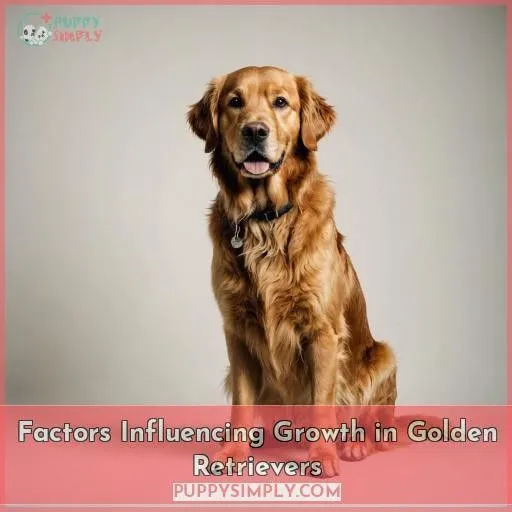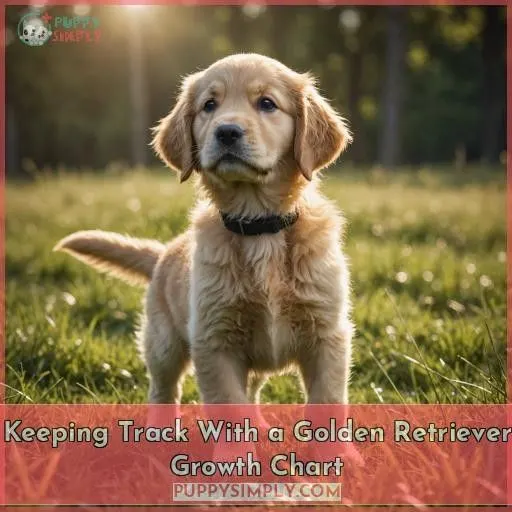This site is supported by our readers. We may earn a commission, at no cost to you, if you purchase through links.

However, their growth journey involves distinct phases – rapid puppy growth, a mini-adult stage, and a final stretch before reaching full size.
While genetics play a role, providing balanced nutrition designed for their growth phase and regular vet check-ups guarantees healthy development.
You’ll recognize a fully grown golden by their well-defined muscles, luxurious coat, and comparable size to a 5-year-old child.
If you’re keen to learn more specifics about their growth timeline and supporting their needs through each stage, you’re on the right track.
Table Of Contents
Key Takeaways
- Golden retrievers typically finish growing around 18-24 months old, reaching their full adult size and appearance.
- Proper nutrition, exercise, and regular veterinary check-ups are essential for supporting healthy growth and development in golden retrievers.
- Genetics and breed standards play a significant role in determining the size and growth patterns of individual golden retrievers.
- Neutering or spaying can slightly delay growth plate closure, allowing golden retrievers to grow slightly taller than intact dogs, but proper care is more important for healthy development.
When Do Golden Retrievers Stop Growing?
Golden Retrievers typically reach their full height by one year of age, but they may continue to fill out and gain muscle until about two years old. While their physical growth is largely complete by 12 months, Golden Retrievers can take up to 24 months to fully mature and reach their adult size.
Growth Phases of Golden Retrievers
The golden retriever puppy growth phase is marked by rapid increases in size and weight during the first few months. As they move into adulthood from around 12 months onward, growth slows markedly while they continue filling out with muscle development.
Puppyhood and Rapid Growth
As a Golden Retriever puppy, you’ll experience rapid growth in your first few months.
From birth to 3 months, you’ll quickly gain size and weight while developing important motor skills.
Between 3-6 months, this growth continues, and you’ll start to resemble a miniature adult.
Proper nutrition and socialization during this vital puppyhood phase will set you up for a healthy, well-adjusted life.
Transitioning to Adulthood
As your Golden Retriever matures, they’ll reach adulthood around 2-3 years old.
Their growth rate will slow, but they’ll continue developing muscle mass and their luxurious adult fur.
Neutering may influence the closure of their growth plates, resulting in a somewhat taller height.
Maintain vigilance for joint concerns such as hip dysplasia.
Collaborate closely with your breeder to safeguard their well-being.
Factors Influencing Growth in Golden Retrievers
As a Golden Retriever owner, comprehending the elements that impact your pup’s growth is essential. Heredity and sustenance have significant roles, with breed guidelines delineating the appropriate size range, while a balanced diet adapted to each growth phase fosters healthy development.
Genetics and Breed Standards
Your Golden Retriever’s size and growth are largely influenced by their genetics and breed lineage. Expect some variability in height and weight, as Goldens come in a range of sizes. Reputable breeders carefully select sires and dams to produce healthy, well-proportioned pups within the breed standard. Understanding your pup’s genetic background can help set realistic expectations for their full-grown size.
- Genetic variation in Golden Retrievers leads to a range of sizes
- Breed standards provide guidelines, but individual dogs may vary
- Responsible breeders consider lineage and health when selecting breeding pairs
Nutrition and Health
Proper nutrition and exercise are essential for your Golden Retriever’s healthy growth.
Avoid overfeeding, which can lead to obesity and skeletal issues.
Choose a high-quality, age-appropriate diet and provide regular exercise customized to your pup’s needs.
Work closely with your veterinarian to address any health conditions that may impact growth.
Selecting a reputable breeder is also key to ensuring your Golden’s well-being.
Recognizing a Fully Grown Golden Retriever
As your Golden Retriever matures, you’ll notice distinct physical changes that signal they’ve reached adulthood.
Look for a well-defined musculature, a thick and lustrous coat, and a fully formed bone structure – all hallmarks of a fully grown Goldie.
Comparing your pup to a 5-year-old human can provide helpful perspective on their size and development.
While jumping ability is influenced by more than just height, it’s important to monitor your Retriever’s growth to make sure they meet any class requirements.
With patience and care, you’ll witness your furry friend blossom into a magnificent adult Golden.
Supporting Healthy Growth
You’ll want to provide your Golden Retriever puppy with a balanced, nutrient-rich diet that’s customized to their specific growth needs.
Make sure they receive regular, age-appropriate exercise to develop muscle and expend energy.
Don’t overlook those important vet visits. They’ll track your pup’s development, identify any health issues at an early stage, and provide guidance on nutrition, exercise, and even the optimal time for spaying or neutering.
Recommended Nutrition and Exercise
Proper nutrition and exercise are key to supporting your Golden Retriever’s healthy growth. Feed a balanced, protein-rich diet and control portions to prevent obesity, which can strain developing joints. Aim for 15-30 minutes of age-appropriate exercise twice daily, avoiding intense activity during rapid growth phases. This balanced approach promotes strong muscles, bones, and joints for your pup.
Regular Health Check-ups
Regular health check-ups are essential for fostering your Golden Retriever’s sound growth. Schedule routine vet appointments to observe for any concerns, stay abreast of vaccinations, and determine the optimal timing for neutering or spaying. Pay close attention to joint health, as Golden Retrievers are susceptible to joint issues like hip and elbow dysplasia.
- Schedule regular vet visits
- Monitor for any health symptoms
- Keep up with vaccination schedule
- Time neutering/spaying appropriately
- Prioritize joint care
What is the Biggest Golden Retriever?
The largest Golden Retrievers are typically males, with some reaching up to 75 pounds and 24 inches tall at the shoulder. However, your pup’s size will depend on their genetics, including their sire’s size. While height is a factor for jumping classes, joint health is more important. Collaborate with a trustworthy breeder to guarantee your Golden grows up healthy and strong.
Keeping Track With a Golden Retriever Growth Chart
To keep track of your Golden Retriever’s growth, follow a breed-specific growth chart that outlines expected weight ranges at various ages – from birth to around 24 months when they typically reach their full adult size. These charts provide helpful guidance, but remember that every puppy grows at their own pace influenced by genetics, nutrition, and overall health.
At Birth (0-4 Weeks)
At birth, your Golden Retriever puppy will weigh less than 5 pounds. These tiny bundles of joy spend most of their time nursing and sleeping, with nursing occurring every 2-3 hours. While their eyes are closed, their other senses are developing, and they’ve minimal socialization needs at this stage. Cherish these early days – your pup’s mental development is just beginning!
- Birth Weight: Less than 5 pounds
- Nursing Frequency: Every 2-3 hours
- Socialization Needs: Minimal
- Sleep Patterns: Majority of time spent sleeping
8. 12 Weeks (2-3 Months)
At 8-12 weeks, your Golden Retriever puppy is experiencing rapid growth and development. They’ll gain weight, changing from nursing to solid food. This is a critical socialization period, so expose them to new sights, sounds, and experiences. But be mindful of their delicate joints – avoid excessive exercise.
| Puppy Age | Weight Range | Feeding Schedule |
|---|---|---|
| 8-12 Weeks | 10-22 lbs | 4 meals/day, 7-9 oz |
| 4-6 Months | 30-44 lbs | 3 meals/day, 9-11 oz |
| 7-12 Months | 48-68 lbs | 2 meals/day, 12-16 oz |
| 16-24 Months | 65-80 lbs | Adult food, portion control |
4. 6 Months
As your Golden Retriever puppy reaches 4-6 months, you’ll notice their growth rate slowing down a bit. But don’t worry, they’re still packing on the pounds! During this stage, you can expect them to gain weight at a steady pace, reaching 41-60% of their adult size. Keep an eye on their height – it may give you clues about their eventual full-grown stature. And remember, proper nutrition and exercise are key to supporting their healthy development.
- Golden weight gain: 30-44 pounds
- Growth rate: Steady, 41-60% of adult size
- Breed size: Clues in height development
- Height prediction: Use as indicator of full size
- Health concerns: Monitor nutrition, exercise
7. 12 Months
By 7-12 months, your Golden Retriever is nearly full-grown, weighing 48-68 pounds. During this stage, focus on their joint health by avoiding excessive exercise and providing a balanced diet. Feed them 12-16 ounces per day in two meals. Make sure you choose a reputable breeder to prevent issues like hip dysplasia. Your pup may not be ready for jumping classes yet.
| Age | Weight | Feeding |
|---|---|---|
| 7-12 Months | 48-68 lbs | 12-16 oz/day, 2 meals |
16. 24 Months
By 16-24 months, your Golden Retriever is officially an adult. Their growth patterns have stabilized, and they’ve reached their full size. You can estimate their adult height and weight by looking at their parents’ sizes. While they may continue filling out, their jumping ability is likely set. Enjoy your fully grown, loyal companion!
- Growth patterns have stabilized by 16-24 months
- Full adult size and height reached during this time
- Estimate adult size based on parents’ measurements
- Jumping ability is largely determined by this stage
- Enjoy your fully grown, loyal Golden Retriever companion
Frequently Asked Questions (FAQs)
How do neutering/spaying affect a Golden Retrievers growth?
Neutering/spaying can delay growth plate closure, allowing your Golden Retriever to grow slightly taller than intact dogs. The effects are minor, however, with proper diet and exercise being more essential for healthy development.
What are the most common growth issues in Golden Retrievers?
I’faith, the most common growth issues in Golden Retrievers are hip and elbow dysplasia, as well as obesity. These can be mitigated through proper nutrition, exercise, and regular vet check-ups.
What is the largest recorded size for a Golden Retriever?
Male Golden Retrievers can reach up to 75 lbs and stand 24 inches tall at the shoulder. These impressive sizes make them gentle giants in the dog world.
How does a Golden Retrievers growth compare to a human childs?
You’ll be amazed by a Golden’s growth rate – it’s like having a miniature human child! Pups grow rapidly in their first year, almost tripling in height before slowing down after 12 months. Their adult size rivals a kindergartner’s stature.
Can a Golden Retriever be trained for jumping competitions?
With proper training, a Golden Retriever can indeed participate in jumping competitions. Their athletic build and energy make them well-suited for agility events, given their height is within the competition’s guidelines.
Conclusion
Envision your golden retriever’s growth journey, from a tiny pup to a magnificent adult.
By understanding their distinct phases, providing balanced nutrition, and regular vet visits, you can contribute to their healthy development.
When do golden retrievers stop growing?
Generally around 18-24 months, recognizable by their well-defined muscles, luxurious coat, and size comparable to a 5-year-old child.
Support their needs at every stage for a lifelong companion.











